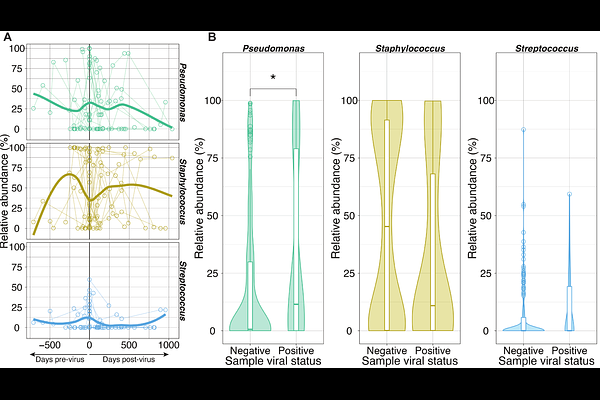Respiratory viral infection is associated with increased Pseudomonas abundance in cystic fibrosis airways

Respiratory viral infection is associated with increased Pseudomonas abundance in cystic fibrosis airways
Hilliam, Y.; Armbruster, C. R.; Atteih, S. E.; Rapsinski, G. J.; Moore, J.; Koirala, J.; Krainz, L.; Gaston, J. R.; Williams, J.; Cooper, V. S.; Lee, S. E.; Bomberger, J. M.
AbstractAcute respiratory viral infections are an important driver of morbidity and mortality in people with chronic lung disease and are frequently associated with pulmonary exacerbations and a transition from intermittent to chronic bacterial infection of the airways. Chronic Pseudomonas aeruginosa infections are associated with worsened lung function, poor outcomes, and increased hospital visits. We sought to improve understanding of the effects of respiratory viral infections and host immune response on the resident bacterial community of the airways, using cystic fibrosis as a model. We performed an observational longitudinal study of 38 adults with CF and collected sinus and sputum samples at 6-month intervals from 2017 - 2021. We performed 16S rRNA amplicon sequencing to characterize the airway microbiota, real-time RT-PCR for viral infection detection, and cytokine quantification. We observed viral positivity rates of 19% and 14% in sinus and sputum samples, respectively. Human rhinovirus was the most frequently observed viral pathogen in both sinus and sputum samples. We measured a significant perturbance of the bacterial community during viral infection that did not return to baseline following resolution of the viral infection. This perturbation was driven by a significant increase in Pseudomonas relative abundance during viral infection. Furthermore, we found significant associations with increased Pseudomonas relative abundance for several pro-inflammatory and antiviral cytokines, including interleukin (IL)-2, IL-8, and interferon (IFN)-{lambda}1. These findings indicate an important role for respiratory viral infections and the host immune response in the development and maintenance of chronic Pseudomonas infections in the context of CF airway disease and broadly expand our understanding of viral-bacterial coinfection of the airways.